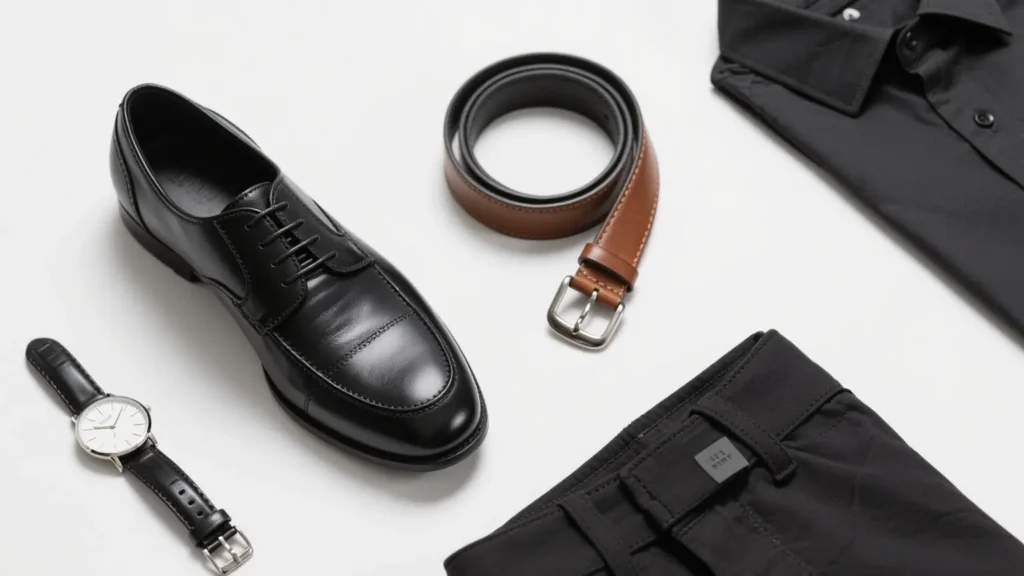7 Powerful Male Belting Rules to Instantly Elevate Your Style

Introduction
When it comes to men’s fashion, few accessories hold as much influence as the belt. Far more than a tool to hold up trousers, male belting is a subtle art that can transform your entire look. The right belt balances proportions, signals attention to detail, and even conveys confidence without a single word. Yet, many men treat belts as an afterthought, often choosing the wrong width, buckle, or color.
In this guide, we’ll uncover 7 powerful male belting rules that will help you instantly elevate your style — whether you’re dressing for the office, a date night, or a weekend getaway.
Table of Contents
- Rule #1 – Match Your Belt with Your Shoes
- Rule #2 – Choose the Right Width for the Occasion
- Rule #3 – Invest in Quality Leather Belts
- Rule #4 – Coordinate Belt Color with Outfit Tones
- Rule #5 – Understand Belt Buckle Styles
- Rule #6 – Adjust Belting to Body Proportion
- Rule #7 – Follow the “Less Is More” Principle
- Bonus Tips for Modern Male Belting
- FAQs About Male Belting
- Conclusion + CTA
Rule #1 – Match Your Belt with Your Shoes
The golden rule of male belting: your belt should harmonize with your shoes. A black leather belt pairs perfectly with black oxfords, while a brown belt complements brown loafers. This simple alignment creates visual consistency and signals sophistication.
- Formal tip: For business suits, keep leather tones consistent.
- Casual tip: With sneakers, you can opt for suede or canvas belts that echo the shoe material.
Recommended to browse our: Leather Belts Collection
Rule #2 – Choose the Right Width for the Occasion
The width of your belt speaks volumes:
- Formal occasions: Stick to slim belts (1–1.25 inches). They slip seamlessly through dress pant loops and enhance elegance.
- Casual settings: Wider belts (1.5–1.75 inches) work better with jeans and chinos. They project rugged masculinity.
Pro tip: A belt too wide or too narrow for the loops instantly looks mismatched — always check compatibility.
Rule #3 – Invest in Quality Leather Belts
Belts are not accessories to cut corners on. A premium leather belt not only lasts years but also ages gracefully, developing a unique patina.
- Full-grain leather: The highest quality, extremely durable.
- Top-grain leather: Slightly processed, still elegant.
- Genuine leather: Avoid if possible — it wears out quickly.
💡 Further reading: Gentleman’s Gazette on Leather Quality
Rule #4 – Coordinate Belt Color with Outfit Tones
Beyond matching shoes, think about the overall palette:
- Navy suit? A dark brown belt adds warmth.
- Grey trousers? A sleek black belt sharpens the look.
- Casual khakis? Tan belts highlight a relaxed vibe.
Modern twist: Don’t fear subtle contrasts. A dark green or burgundy belt can be a stylish statement if balanced with accessories like a watch strap.
Rule #5 – Understand Belt Buckle Styles
Buckles are the centerpiece of male belting. Choosing the wrong one can ruin the outfit:
- Classic frame buckle: Best for formalwear.
- Plate buckle: Popular in Western and casual styles.
- Box-frame buckle: Rugged, ideal for casual trousers.
- Micro-adjust ratchet buckle: Modern, sleek, and versatile.
👉 When in doubt, stick to subtle, metallic buckles in silver or gold, matching your watch or cufflinks.
Rule #6 – Adjust Belting to Body Proportion
A belt should enhance your body shape, not distort it:
- Shorter men: Avoid overly wide belts, which shorten leg lines.
- Taller men: Can experiment with slightly wider styles for balance.
- Slim men: Stick to minimal buckles to avoid bulk.
- Larger builds: Wider belts with sturdy buckles provide proportion.
Think of belts as a frame for your torso-to-leg ratio.
Rule #7 – Follow the “Less Is More” Principle
Flashy belts with oversized logos may grab attention, but they rarely communicate timeless elegance. Instead, opt for clean, minimal designs. A belt should complete your outfit, not compete with it.
Remember: true style whispers, it doesn’t shout.
Bonus Tips for Modern Male Belting
- Switch belts seasonally: Lighter tones for summer, darker for winter.
- Experiment with textures: Braided leather, canvas, or suede for variety.
- Care for your belts: Store them flat or rolled, condition leather every few months.
FAQs About Male Belting
Q1: How many belts should every man own?
At least three: one black leather, one brown leather, and one casual option (canvas or suede).
Q2: Can I wear the same belt every day?
You can, but it will wear out faster. Rotate between belts to extend their lifespan.
Q3: Should the belt always match the watch strap?
Not always, but coordinating them adds refinement. Matching metals (silver buckle with silver watch) is more important.
Q4: What’s the best belt for jeans?
A sturdy, wider leather belt with a simple buckle is the most versatile.
Q5: Are automatic ratchet belts stylish or gimmicky?
Modern ratchet belts are practical and sleek — they’re increasingly accepted in both casual and business settings.
Conclusion + CTA
Mastering the art of male belting is about more than utility — it’s a statement of refinement. By following these 7 powerful rules, you’ll not only secure your trousers but also project confidence, class, and style in every setting.
👉 Looking for the perfect men’s belt? Explore our leather belts collection today.
👉 Upgrade your wardrobe with a premium leather belt — shop now and experience timeless elegance.
